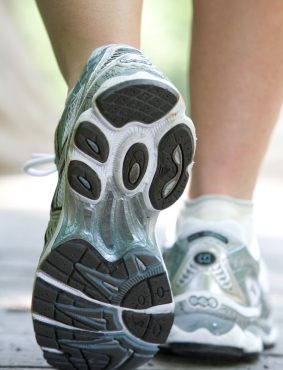
Here’s a story about the Swiss you may not have heard. They are the world’s biggest producers and consumers of chocolate—more than 20 pounds a year per person—and yet they are not tipping the scales in the world weight-gaining Olympics.
Why? Half of their run-of-the-mill getting around is done on foot or bicycle. Americans on average travel on their own steam less than 10% of the time. We French claim little resemblance to the Swiss except in the domains of chocolate and walking, where we are more than respectable performers.
Every time we are in France for a week or more, my husband is astounded that we both shed a pound or two, even as we seem to eat more. The trick: we walk a lot.
Walking is an essential part of the French way of life, and the average French woman walks three times as much as the average American. For the whole lower half of your body, there could be no better exercise: you work the legs top to bottom, the buttocks, particularly if your strides are long. And the cardiovascular benefits of brisk walking have been shown to be as good as those of running but without endangering your joints.
I urge you to increase your walking in two ways:
First, add regular “dedicated” walks to your day. Not death marches, just smart strolls. Start small, if you like and make them a little longer each day. Whether it’s walking to work all or part of the way, or a half hour after dinner (good for digestion and unwinding), adding three hours of walking to your week is a painless and reliable way to weight loss. When you begin to see it working for you, you’ll find yourself automatically walking more.
Second, look for ways to increase your “incidental” walk time. This means resisting the American impulse to save a step. We French are not as fiendish about finding shortcuts as Americans are. Perhaps it is why we are no longer a great power, but the trade-off is that we are not fat. In life we believe the journey is the destination. If you’re not that philosophical, remember it simply: time saved=calories not burned. Have a little walk around while waiting for someone (as we say faire les cent pas, literally “walk a hundred steps”).
Contrary to popular wisdom, walking is not as simple as chewing gum. Any physical activity must be pursued thoughtfully, with an eye to balance and harmony. So, what is the best way to walk? Avoid treading congested streets and carrying heavy things. (Even if you can manage that bag, its weight creates a subconscious incentive to avoid walking next time). Stilettos are not a good idea, but you don’t need garish running shoes either. French women wear comfortable loafers, pumps or rubber-soled lace-ups that are presentable anywhere. City parks and roads without traffic in the country are great places to walk, but even the air-conditioned mall will do fine if being outdoors is not bearable where you are. I know an 88-year-old woman who lives in the suburbs and all winter long she takes a daily walk in a huge supermarket. To each her own. Of course, city or country, you’ll probably come to know your walk preferences only if you pay attention. Some respond to nature, others to people watching. Discover what engages you.
Yes, Form Matters
The most important aspects of walking are posture and breathing. It’s vital to hold your head erect and keep your back straight, chin up, as though your attention is fixed on some point in the distance, or on looking for a lover in a foggy train station. But watch your step, too. (I know people who’ve found a lot of change in the street just looking down from time to time.) Relax your shoulders then arch them back (feels like pushing out your chest) so you can imagine a little brook running down your back between your shoulder blades and be conscious of keeping them in that position. After a while it becomes automatic. Bad posture in walking will announce itself with a sore neck and back.
Inside The Stride
Inhale and exhale deeply and slowly; concentrating on your breathing will improve the meditative value of your walk. As with eating, awareness heightens the overall stimulation of the experience, and stimulation = satisfaction. Your gait is important too: use your arms and don’t walk on the ball of the foot only; heel and toe is the way to go. Always carry and drink water. Before you know it, you’ll be there.
On weekdays during my first two student years in Paris, I used to walk between the Eiffel Tower on the Right Bank and the Sorbonne on the Left, a different route going and coming, (though avoiding pastry shops each way while that was still necessary). On the weekends, my roommate and I, both provincial girls discovering Paris with very wide eyes, would spend Saturdays walking the different arrondissements or gardens or along the banks of the Seine. Often we must have walked 6-8 miles stopping only for lunch and a five o’clock ice cream—that little weekly reward—at the famous Berthillon on the Île St Louis. In the end we knew the city better than most Parisians.
For me, walking remains the ultimate time for freedom of thought. It’s when I feel my tensions liberated and a kind of bien-être, as the promenade of the mind follows that of the body. It can be a very special kind of indulgence, these moments when one becomes aware of really existing, as the images, information, and other sensations the world tries to press upon us all recede. Learning to be comfortable in that space, when it’s just you, takes practice. But doing so diminishes the impulse to lie to yourself or run away. You won’t want to.
